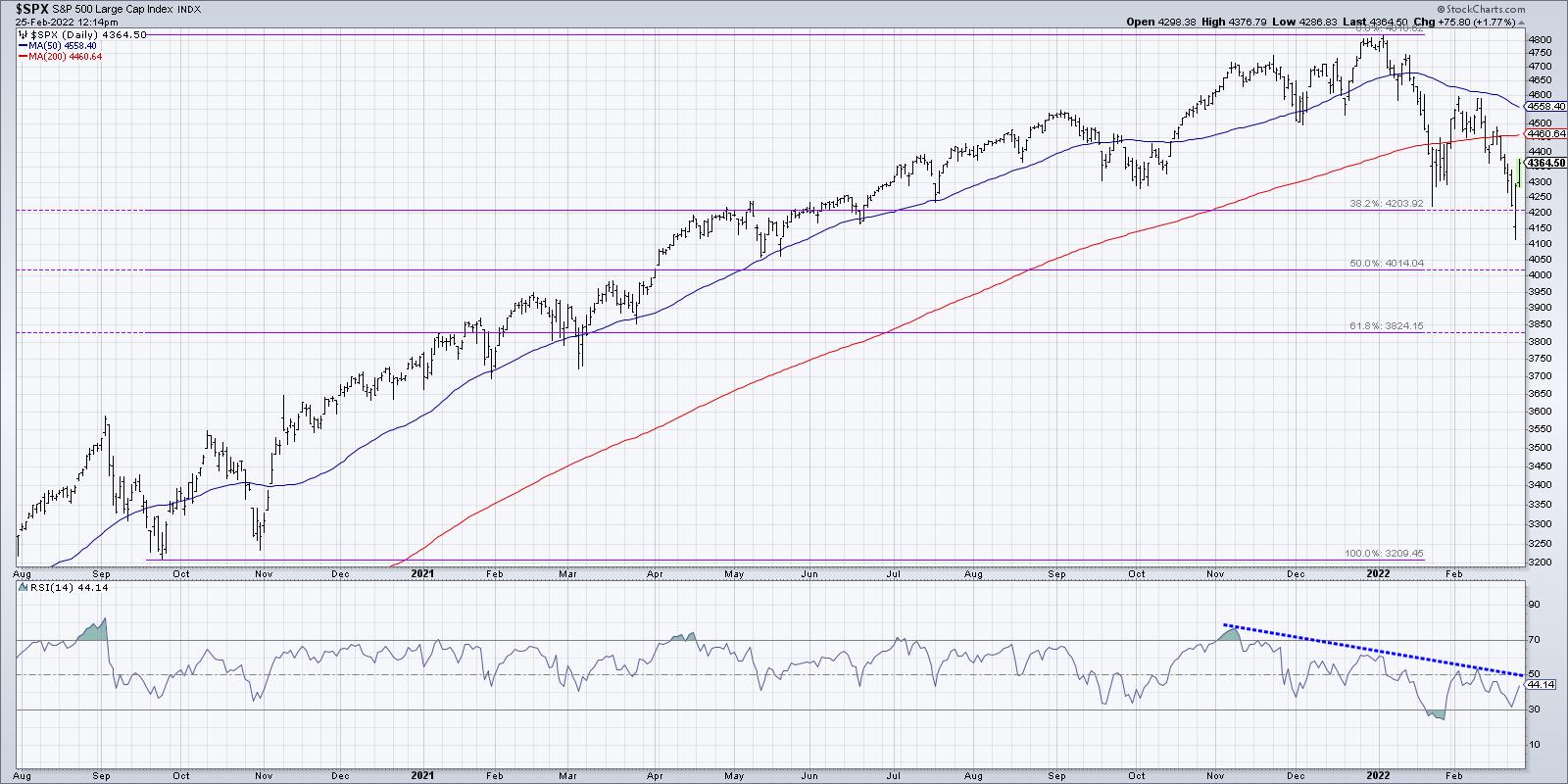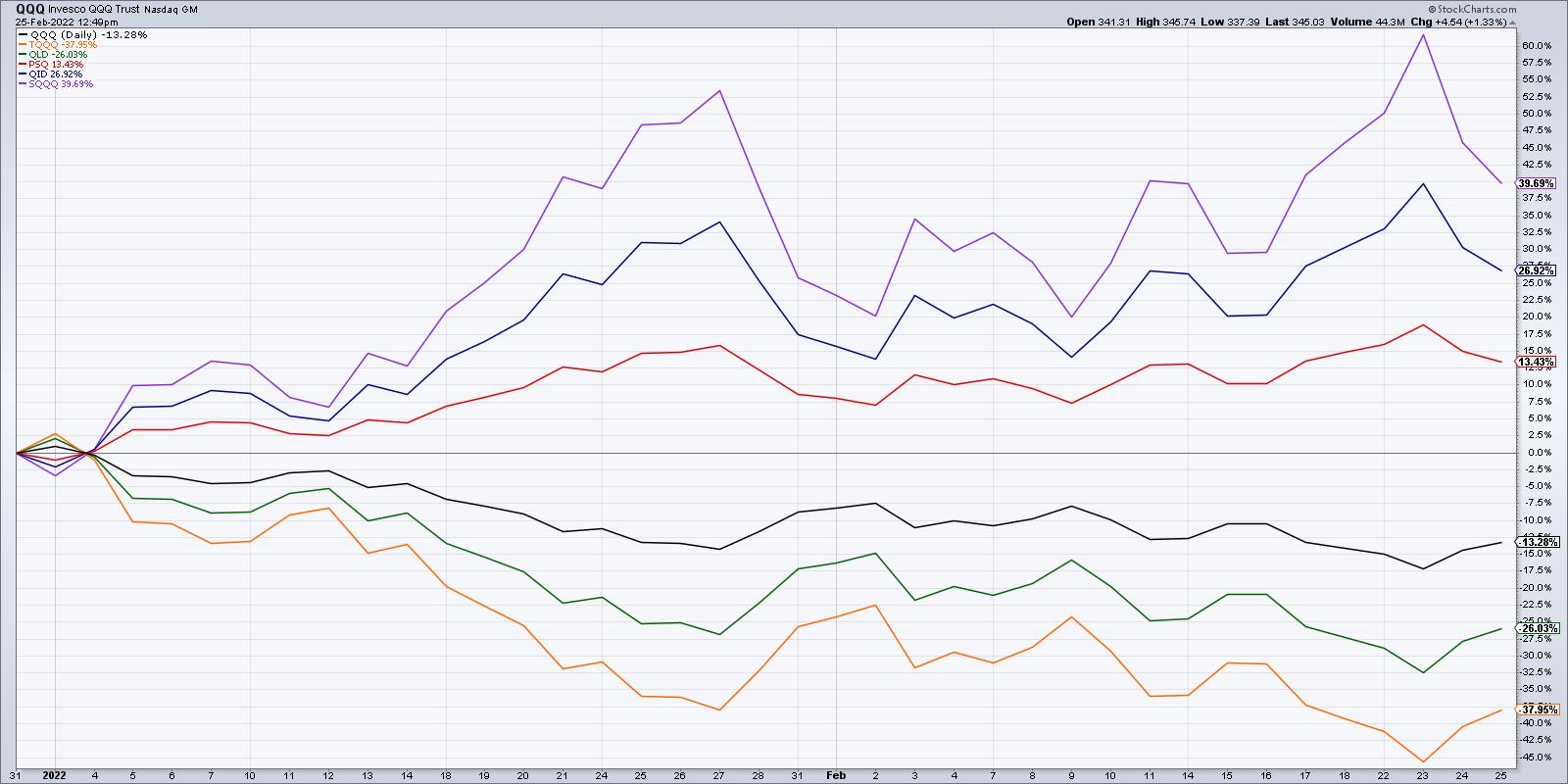"There is nothing more painfully bullish than a bear market rally."
- Dave Keller, The Final Bar, February 24, 2022
We've been tracking the signs of distribution since November of last year. As the S&P 500 made new highs into December and January, the underlying conditions of the market were changing. Breadth conditions started to deteriorate, with bearish divergences in the advance-decline lines. We also noted bearish momentum divergences as the S&P 500 was making new highs on lower RSI readings. We even discuss the Hindenburg Omen and why the confirmed signals in late 2021 suggested a painful start to 2022.
Now, the S&P 500 has reached its first downside Fibonacci target around 4200. That's the 38.2% retracement level based on the move from the September 2020 low and the January 2022 high.

When the S&P first reached the 4200 area in mid-January, we saw about a 9% bounce from intraday low to the next swing high in early February. On a closing basis, this was about a 6% upside move. Then, we continued the longer-term downtrend to reach 4200 again this week. In neither case did we actually close below 4200, which is an important data point to keep in mind!
While I believe the longer-term trend remains lower, and I remain convinced that the low is not yet in for this down move, I do recognize that short-term strength suggests upside potential before the next leg down.
So how do we play this sort of environment? Honestly, the answer to that question very much depends on your time frame. If you're a medium to long-term investor, as I am, then my Market Trend Model remains bearish, which indicates that we remain a risk-off environment until proven otherwise. That leads me to the latter half of this week as a countertrend move, a.k.a. a bear market rally. Bear market rallies tend to be super quick, super powerful and super seductive.
So how do we differentiate a bear market rally from a true market bottom? Four things come to mind...
- A higher low. A downtrend is a series of lower lows and lower highs. An uptrend is a series of higher highs and higher lows. How can we confirm a rotation from a bear market phase to a bull market phase on any time frame? You need a higher low.
- Improvement in breadth conditions. Breadth has been deteriorating, with the cumulative advance-decline line for the NYSE undercutting its low from 4th quarter 2021. The A-D lines turning higher would indicate that individual names are bouncing enough to confirm a new uptrend.
- Improvement in price momentum. The S&P saw its RSI slope steadily lower as it made new highs in December and January (see the S&P 500 chart above). That downtrend in momentum continued as the price move lower over the last six weeks. I would need to see the RSI break above trendline resistance, then continue above a level of 60, before I would believe any sort of significant uptrend is in place.
- Price break above resistance. As the market bounces higher, we now need to consider potential resistance levels. An uptrend with staying power needs to push above established resistance levels to confirm that buying power is enough to overwhelm any potential selling pressure. The 200-day moving average current sits around 4460, and the previous swing high is right at 4600. If and when the S&P breaks above 4600, you will hear my voice become much less cautious and much more "long and strong" as the all-time highs around 4800 would be much more attainable.
Now what about leveraged ETFs? When the market moves lower, I'm often asked about inverse ETFs and their cousins, the leveraged inverse ETFs. Do these vehicles make sense for short-term traders? Absolutely. Actually, that is for whom they were created! Inverse ETFs were designed to track the inverse daily returns of the underlying index. So if the QQQ is up 1% today, the PSQ will be down right around 1%. The leveraged forms simply track 2x or 3x of that daily return.
Here's a chart of the QQQ along with the 2x and 3x leveraged long ETFs, along with the inverse 1x, 2x and 3x leveraged ETFs.

Should they be used by long-term investors? Yes, if you understand the risks that are embedded in the structure of the individual products!
My latest YouTube video breaks down some of the risks involved and how long-term investors can use these inverse and leveraged products!
RR#6,
Dave
David Keller, CMT
Chief Market Strategist
StockCharts.com
Disclaimer: This blog is for educational purposes only and should not be construed as financial advice. The ideas and strategies should never be used without first assessing your own personal and financial situation, or without consulting a financial professional.
The author does not have a position in mentioned securities at the time of publication. Any opinions expressed herein are solely those of the author, and do not in any way represent the views or opinions of any other person or entity.






